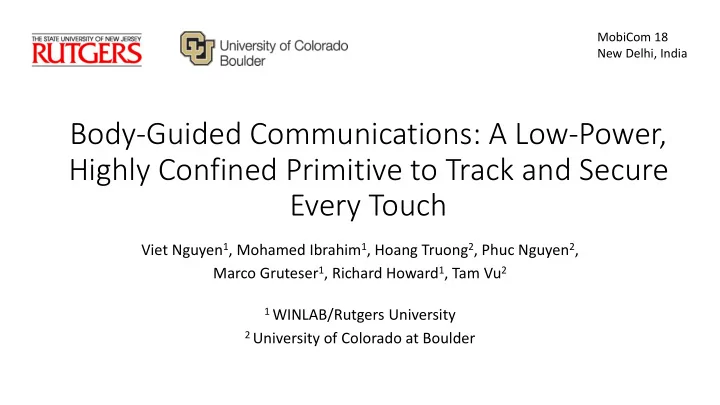

MobiCom 18 New Delhi, India Body-Guided Communications: A Low-Power, Highly Confined Primitive to Track and Secure Every Touch Viet Nguyen 1 , Mohamed Ibrahim 1 , Hoang Truong 2 , Phuc Nguyen 2 , Marco Gruteser 1 , Richard Howard 1 , Tam Vu 2 1 WINLAB/Rutgers University 2 University of Colorado at Boulder
Motivation: User identification/authentication Overhead for authentication Increasing number of devices Multiple users working on the same device Decreasing interaction time A convenient yet secure user identification/authentication is desirable 11/5/2018 Body-Guided Communications 2
Existing user identification/authentication techniques • Vulnerable to man-in-the-middle attack • Radio tokens • NFC • Low data rate • SignetRing [1] • Hessar et al. [2] • High power consumption • Vibratory communication [3] [1] Vu et al. “Distinguishing Users with Capacitive Touch Communication” [2] Hessar et al. “Enabling On - body Transmissions with Commodity Devices” [3] Roy et al. “Ripple II: Faster Communication through Physical Vibration” 11/5/2018 Body-Guided Communications 3
Key idea A body-guided communication system that ▪ Confines signal to a few cm around the hand ▪ Achieves high data rate to transmit a complete authentication code on every touch Increasing use of wearable devices ▪ Achieves low power consumption Most interactions are through touch 11/5/2018 Body-Guided Communications 4
On On-body communication Capacitive Coupling Resistive Coupling • • Path loss is much more dependent on the The received signal decreases with Tx-Rx distance • surrounding environments The received signal is higher when interelectrode spacing is longer 11/5/2018 Body-Guided Communications 5
Challenges RX: inter-electrode distance too small Resistive Coupling • The received signal decreases with Tx-Rx distance • The received signal is higher when interelectrode RX: electrodes hidden behind non-conductive layers spacing is longer 11/5/2018 Body-Guided Communications 6
Body-guided Communication Electrode Major path Epidermis Minor path Conductive Tissue Cff : the limiting factor when the finger moves away from the touch surface → Touch association for per- touch authentication 11/5/2018 Body-Guided Communications 7
Wearable prototype design H = 2.4cm d = 0.6cm H = 2cm d = 0.3cm 11/5/2018 Body-Guided Communications 8
Design of f electrode on touched devices Electrode size: 1cm 2 Electrode size: 13x6cm 2 Under the front-facing case (1mm thick) On the back of the phone (phone thickness = 1cm) 11/5/2018 Body-Guided Communications 9
Receiver design ❖ Dual-buffered memory ❖ Ping-pong DMA → real-time decoding 11/5/2018 Body-Guided Communications 10
Received signal Transmitter modulates a 128-bit ID using OOK Carrier frequency = 150KHz Signal after mixing at the receiver = 5KHz Zoomed-in from red area on the left 11/5/2018 Body-Guided Communications 11
Highly-confined signal Protection against remote monitoring Per-touch authentication Low-power @ Intended Receiver Adversary receiver Wearable token signal advantage @ Adversary Receiver Intended receiver 11/5/2018 Body-Guided Communications 12
Highly-confined signal Protection against contacts Per-touch authentication Low-power User Conductive Surface Adversary User TX TX Table RX RX RX User TX Adversary Metal Base Shared screen Signal advantage is always greater than 10dB No positive signal advantage possible for RF, NFC, etc. 11/5/2018 Body-Guided Communications 13
Highly-confined signal Per-touch authentication/identification Per-touch authentication Low-power • 2170 touches over 5 days • Touch duration: 50.7ms - 1.78s • 32, 64, 128, and 256-bit code • Data rate: 1kbps For 128-bit code: 89.5% accuracy for 200-300ms touch duration 100% for above 300ms touch duration 11/5/2018 Body-Guided Communications 14
Highly-confined signal Power consumption Per-touch authentication Low-power Energy per bit 100000 200mW@2kbps 3.9mW@1kbps (100uJ/bit) 10000 (3.9uJ/bit) Current MSP430-based prototype Susceptible to eavesdropping nj/bit 1000 No touch association 100 nJ/bit nJ/bit Theoretical limit 90nJ/bit 10 1 Body-guided Vibratory RF NFC Communication communication 11/5/2018 Body-Guided Communications 15
Conclusion • Proposed a body-guided communication method for securing every touch interaction from users with a variety of devices • More secure against eavesdropping than other wireless methods • The signal received at the intended receiver is at least 20dB higher than that at an adversary’s receiver in proximity • Low power consumption • Token consumes 3.9uJ/bit, much lower than vibratory communication (per- touch communication) • Robust per-touch authentication • Reliably deliver a 128-bit ID code on every touch longer than 300ms Thank you! 11/5/2018 Body-Guided Communications 16
Recommend
More recommend